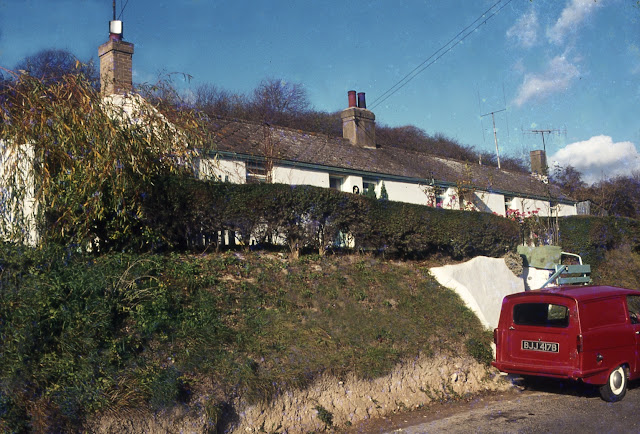 |
| Warren House, North Halling, January 2022... |
Along
 |
| Portland Row, Pilgrims Road, looking east, c. 1910... |
If you look around the edge of the bank by the road at Warren House, you can still see a course of the original red bricks that may have formed the foundations of the Whorne's Place estate building, The red clay bricks do seem to be of a similar type to those used in the fabric of Whorne's Place. It was clearly quite substantial, certainly larger than the granary building on the Rochester Road we call 'Whorne's Place' today. Very little seems to be known about Halling’s current Warren House itself.
 |
| Brick foundations of the original Warren House? |
The Kent Archaeological Society’s 2011 review, “Monumental Inscriptions of St Michael's Church, Cuxton”, tells us that the Halling burial register notes that a Mrs. Anne Siddall died in Warren House in 1825 and is buried in the graveyard at
The 1901
census mentions Warren House, as well as 1-11 Portland Row, Bank Cottages (a row of four tiny terraced cottages on the bank opposite Whorne's Place: only two are mentioned in the Halling census as the parish boundary passed through the middle of the terrace, the other two appearing on the Cuxton census!) and 1-4 Clinkham
Cottages. The occupations of those listed as living there seem to be largely
associated with the nearby Trechmann and Weekes cement company who worked the
Bores Hole pit which lay between Church Hill and
 |
| Bores Hole pit, with the Trechmann and Weekes works in the background... |
Some of the Portland Row residents are family names with strong links to the Cuxton and Halling area: William (“Boner”) Baker and his family are listed as living at No.1 Portland Row, William being referred to as a “horse driver”.
 |
| William "Boner" Baker, resident of No.1 Portland Row... |
Thomas Woolmer (“cement labourer”) and his family lived at No.8, with James Bonneywell and his family living at Warren House, along with Richard Rowe, a boarder and fellow cement labourer.
Portland Row was built in the 1850s, probably by Trechmann and Weekes. At the time, it was common practice for the local cement companies to provide housing and amenities for their workforce, the names of the houses, terraces and roads often reflecting the companies that built them.
The 1869 OS map for the area shows Warren House and the
newly-built Portland Row, calling the latter “Sebastopol” (presumably in
commemoration of the siege of
 |
| Ordnance Survey map 1868 showing Portland Row (also called Sebastopol Terrace or Iron Cottages) |
A later map of 1898 shows that an additional row of small cottages to the east of Portland Row had been built. I think these may be the “Clinkham Cottages” referred to in the 1901 census, given that there are four of them and their listing in the same area as Portland Row and Warren House.
 |
| 1898 OS Map, showing Portland Row (Sebastopol Terrace) and Clinkham Cottages to the north... |
At that time, No.1 Clinkham Cottages was occupied by Mr. Reuben Wraight and his family, with No.3 being the residence of another Wraight family (another name with strong local connections) that of Mr. Thomas Wraight. Both Reuben and Thomas Wraight were listed as “railway engine drivers”, presumably working on the engines used in the cement quarries.
At the beginning of the twentieth century, Formby Brothers operated the Clinkham lime plant at Halling (the Formby works, which became Batchelors, and then latterly Rugby Portland) and mined the Clinkham Grey pit (now called, by some, Blue Lake or St. Andrews Lake). The cottages may have been built by Formby’s and were certainly named after the associated works.
 |
| Clinkham Cottages (latterly known as Portland Villas), 1972 (photo by Derek Church)... |
 |
| Portland Row, c.1950. The steps and the base of the gas lamp can still be seen in the bank. |
It has been said that Warren House was part of Portland Row but as stated above, I believe it pre-dates it. The photos show the west-facing aspects of both buildings, and it can be seen that the chimney structures are different.
 |
| Demolition of outbuilding at Warren House, 1974, showing old brick oven (photo by Derek Church)... |
 |
| View of Warren House with Portland Row just visible behind the trees (photo by Derek Church, 1974) |
Portland Row and Clinkham Cottages were occupied until at least the 1970’s, but (like so many other Cuxton and Halling buildings) had become difficult to maintain to modern standards. The OS Map of 1970 still showed them in existence but they were finally demolished in the mid-1970s.
 |
| Portland Row, 1972 (photo by Derek Church).. |
 |
| Clinkham Cottages, looking west with Portland Row in the background, 1972 ( Derek Church)... |
Warren House still remains and two modern bungalows were built on the site roughly between where Portland Row and North Halling Cottages were. Portland Row itself was never redeveloped and remains unoccupied as scrubby woodland.
 |
| Modern bungalows on the site of Portland Row/Clinkham Cottages... |
This seems rather curious given the rapacity of developers and the fate of other old buildings in the area, such as the Paddock and Bridge House in Halling and the Old Post Office Row in Cuxton.
No comments:
Post a Comment